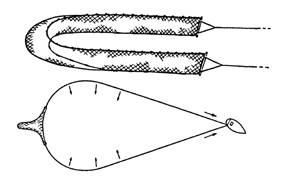angielskiDiagnosis: Large specimens of Dasyatis centroura are recognizable by their thorny tails, by the large size and wide spacing spacing of their mid-dorsal bucklers, and by the conspicuous tubercles or bucklers on the outer parts of their discs; in smaller specimens the large tubercles have not yet developed on the tail (Ref. 6902). It differs from Dasyatis sabina, D. guttata and Himantura schmardae in the shape of disc; it resembles Dasyatis say and D. americana in shape of disc, but it can be distinguished from D. say by the fact that the tail lacks any trace of a cutaneous fold above, and from D. americana by its much narrower ventral tailfold (Ref. 6902).
Description: A very large stingray; disc rhombic, the anterior margins forming a blunt angle (Ref. 6902, 39859, 81259). Dorsal surface entirely, but irregularly rough, with a mid-dorsal row of large thorny tubercles provided with striate bases and erect cusps; a few similar tubercles scattered over pectoral fins and head (Ref. 81259). Tail whip-like and strongly spinous, with numerous rows of small spines; tail with a short dorsal ridge behind the sting and a poorly developed ventral fold, which is long long, but quite low and not easily seen (Ref. 7251).
Colouration: Dorsal side dark brown to olivaceous-brown; the lower surface whitish, with or without dark pectoral margins; tail blackish behind the sting (Ref. 6902, 81259).
Zobacz tłumaczenie
Przetłumaczone z angielski przez BING
Niniejsze tłumaczenie ma charakter czysto wskazujący: z uwagi na ograniczoną jakość tekstu źródłowego, opisy morfologiczne są dostępne tylko w języku angielskim w wersji beta systemu. Informacje w innych językach zostaną udostępnione w kolejnych wersjach.
polskiDiagnoza: Duże okazy Dasyatis centroura są rozpoznawalne przez ich Cierniste ogony, duży rozmiar i odstępy szeroki rozstaw ich połowie grzbietowej bucklers i wyrazista guzków lub bucklers na zewnętrznej części ich płyt; w mniejszych okazów dużych guzków nie zostały jeszcze opracowane na ogonie (Ref. 6902). Różni się on od Dasyatis sabina, D. guttata i Himantura schmardae w kształcie dysku; to przypomina Dasyatis powiedzieć i D. americana w kształcie dysku, ale to można odróżnić od D. powiedzieć przez fakt, że ogon brakuje jakichkolwiek śladów fałd skórny powyżej oraz z D. americana przez jej dużo węższy brzuszne tailfold (nr Ref. 6902).
Opis: Bardzo duże stingray; płytę rombowe, margines przedniej tworząc tępe kąt (Ref. 6902, 39859, 81259). Grzbietowej powierzchni całkowicie, ale nieregularnie szorstki, z połowy grzbietu rząd dużych guzków Moloch z striate baz i wyprostowany guzków; kilka guzków podobne rozrzucone płetwy piersiowe i głowę (Ref. 81259). Ogon przypominał i zdecydowanie pająkowatego, z licznych wierszy małe kolce; ogon Krótki grzbietu grzebień za żądło i słabo rozwiniętych brzusznej fałd, który jest długi, ale bardzo niskie i nie łatwo widoczne (Ref. 7251).
Zabarwienie: Po stronie grzbietowej ciemny brąz olivaceous-brązowy; dolnej powierzchni białawy, z lub bez ciemnych marginesy piersiowych; ogon czarniawy za żądło (Ref. 6902, 81259).
 Obraz niedostępny
Obraz niedostępny









